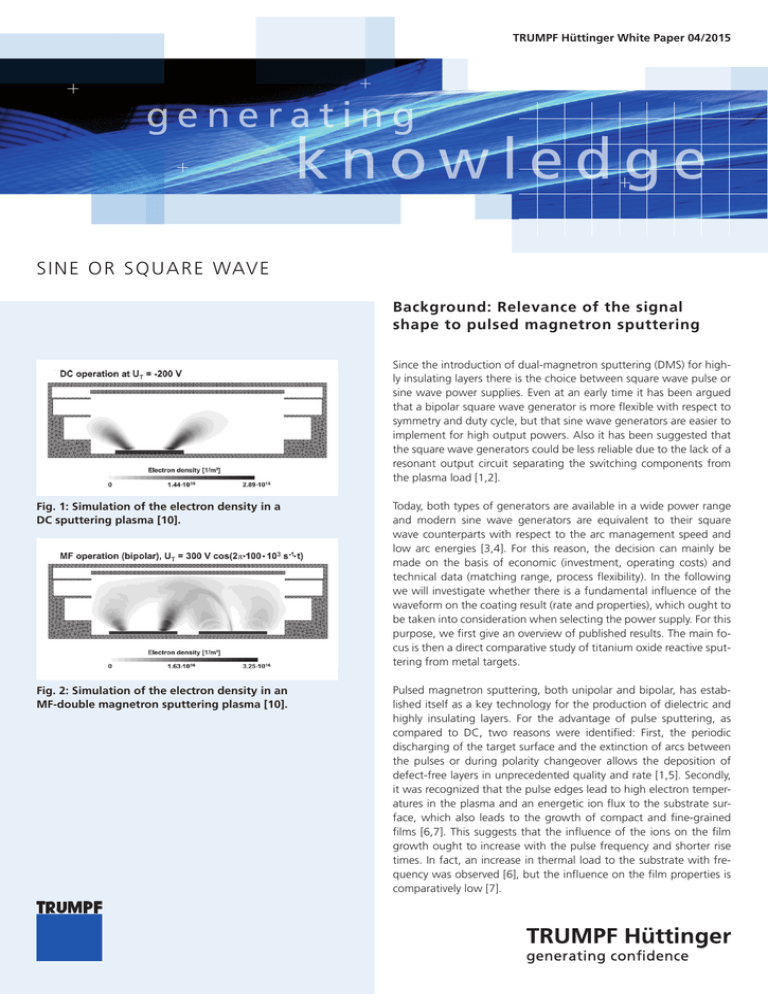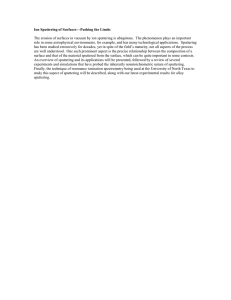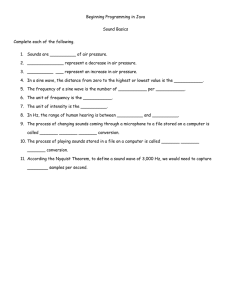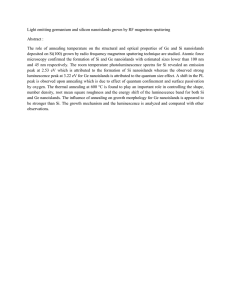
TRUMPF Hüttinger White Paper 04/2015
generating
knowledge
SINE OR SQuARE WAVE
Background: Relevance of the signal
shape to pulsed magnetron sputtering
Since the introduction of dual-magnetron sputtering (DMS) for highly insulating layers there is the choice between square wave pulse or
sine wave power supplies. Even at an early time it has been argued
that a bipolar square wave generator is more flexible with respect to
symmetry and duty cycle, but that sine wave generators are easier to
implement for high output powers. Also it has been suggested that
the square wave generators could be less reliable due to the lack of a
resonant output circuit separating the switching components from
the plasma load [1,2].
Fig. 1: Simulation of the electron density in a
DC sputtering plasma [10].
Today, both types of generators are available in a wide power range
and modern sine wave generators are equivalent to their square
wave counterparts with respect to the arc management speed and
low arc energies [3,4]. For this reason, the decision can mainly be
made on the basis of economic (investment, operating costs) and
technical data (matching range, process flexibility). In the following
we will investigate whether there is a fundamental influence of the
waveform on the coating result (rate and properties), which ought to
be taken into consideration when selecting the power supply. For this
purpose, we first give an overview of published results. The main focus is then a direct comparative study of titanium oxide reactive sputtering from metal targets.
Fig. 2: Simulation of the electron density in an
MF-double magnetron sputtering plasma [10].
Pulsed magnetron sputtering, both unipolar and bipolar, has established itself as a key technology for the production of dielectric and
highly insulating layers. For the advantage of pulse sputtering, as
compared to DC, two reasons were identified: First, the periodic
discharging of the target surface and the extinction of arcs between
the pulses or during polarity changeover allows the deposition of
defect-free layers in unprecedented quality and rate [1,5]. Secondly,
it was recognized that the pulse edges lead to high electron temperatures in the plasma and an energetic ion flux to the substrate surface, which also leads to the growth of compact and fine-grained
films [6,7]. This suggests that the influence of the ions on the film
growth ought to increase with the pulse frequency and shorter rise
times. In fact, an increase in thermal load to the substrate with frequency was observed [6], but the influence on the film properties is
comparatively low [7].
TRUMPF Hüttinger White Paper 04/2015
Fig. 3: Example of current, voltage and instantaneous
power with a sine wave generator (40kW, 524V, 96A).
A fundamental difference between unipolar pulsed sputtering and
dual magnetron sputtering (DMS) is the use of a magnetron as the
anode. Apart from the fact that the anode then is not covered by an
insulating layer due to the alternating sputtering from the two targets, it is also magnetically shielded so that electrons can reach there
only along the field lines1. Consequently, in DMS, the plasma density
in front of the substrate and thus the ion flux is higher than with a
non-magnetic anode, the ion current density and ion energy being
mainly determined by the field strength of the magnetron [8]. With
DMS significantly harder layers have been achieved as compared to
unipolar pulsed sputtering [9]. This shielding effect is also impressively illustrated by simulations, shown in Figure 1 and 2 [10]. When
DC sputtering, the electrons are concentrated above the race tracks
of the cathode. In DMS the current path is perpendicular to the anode (right magnetron), through which the plasma is pushed towards
the substrate.
Sometimes it is argued that a square wave generator is the best
choice for reactive sputtering, as it will deliver voltage, current and
power at approximately 100% duty cycle during each half-wave. Ideal
waveforms are seen with a resistive load, however, in a real magnetron installation, the waveforms may be significantly distorted as
shown in the examples of Figure 3 for a sine wave generator and in
Figure 4 for a bipolar square wave. Thus there is no “quasi DC“.
Fig. 4: Example of current, voltage and instantaneous
power with a square wave generator; target and
process conditions as in Figure 3 (40kW, 490V, 100A).
Fig. 5: Mean ion energy on the substrate, measured
with a retarding field analyzer.
Background: Current state of knowledge
regarding the effect of signal shape on
the coating process
There are only few publications on the influence of the power waveform on the coating result. In [11] the authors compare planar and
rotary targets powered with sine and bipolar pulsed supplies. The
conclusion is for reactively sputtered TiO2 that the influence of the
power supply type on layer properties is small, whereas the target
type is more relevant. A comparison of square and sine wave for
sputtering ITO from an In(Sn) target is presented in [12]. ITO is a particularly sensitive layer system with respect to the plasma parameters,
since both the light absorption and electrical conductivity are very
sensitive to the conditions during deposition. The waveform resulted
in some differences in electron temperature and density near the substrate, but the film properties (optical absorption, el. resistivity) and
the structure (X-ray diffraction) did not depend significantly on the
exciting wave form, as long as the same electron density near the
substrate was selected. In a comparison of HfO2, sputtered with a
bipolar pulser and MF sinus, the latter showed a slightly higher refractive index [13].
1) The earth's magnetic field has a similar shielding effect, so that charged particles penetrate only at
the poles into the atmosphere and cause the aurora.
TRUMPF Hüttinger White Paper 04/2015
Case Study:
Comparison sine vs. square wave for TiO 2
Fig. 6: Comparison of deposition rate as a function of
frequency for sine and square wave excitation of the
DMS sputtering plasma
In order to obtain a clearer picture of the possible influence of the
waveform, a comparative study on reactive sputtering of TiO2 from
planar metallic targets was carried out. It was conducted on the Leybold A700V in-line sputtering system of the Fraunhofer IST in Braunschweig. The MF power was kept constant at 10 kW with 750 mm
target length. For electrical process characterization, currents and
voltages were recorded at the cathodes and the ion flux in the substrate plane was measured with a retarding field analyzer. Films were
deposited and characterized optically by transmission and reflection
measurements and on selected samples by ellipsometry as well as
structurally by X-ray diffraction.
Figure 5 shows the average ion energy for both generators to increases with frequency. This is consistent with previously reported
finding that high-energy ions are generated at each polarity change,
so that their share in the total flux is higher at high frequencies. Both
generators behave similarly in this respect.
Fig. 7: Values of the refractive index at 550 nm wavelength for the layers in Figure 6.
Fig. 8: Dynamic deposition rate and refractive index for
the square wave generator as a function of delay time.
The (dynamic) deposition rates are compared in Figure 6. The influence of the frequency on the rate is low, as it was already reported
[1,14]. The square wave generator shows a slightly higher deposition
rate. The refractive index or optical density shows the opposite trend.
As Figure 7 shows, here the values for the sine wave generator are
slightly higher. In optical coatings, the target is often the so-called
optical thickness, the product of refractive index with thickness
n*thk. Taking into account that under practical conditions several
factors in a coating process can affect the refractive index and rate,
the differences shown here are not really significant.
With the square wave generator, some control of the output shape is
available. By setting a delay time in the ”Bipulse“ or “Trapezoidal“
modes, the changeover between positive and negative half waves
may be delayed; the signal shape thus becomes more similar to a sine
wave. As Figure 8 shows, the coating result is then also altered: The
refractive index increases with increasing delay time and the rate decreases, so that the values approach those of the sine wave power
supply. Zero delay time corresponds to the regular square wave operation here.
Examination of the samples by X-ray diffraction showed the differences
in refractive index observed here to be determined by the ratio of rutile
to anatase. The rutile content is about 63% for samples with a refractive index of 2.58 and at about 70% for samples with n of 2.64.
TRUMPF Hüttinger White Paper 04/2015
Conclusion: Basis for decisions on the
power supply type
n The current experimental findings are consistent with the few data
in the literature: There is some influence of the waveform on the thin
film growth, but it is expected that other unavoidable factors, such as
the changing magnetic field with target erosion are much more pronounced. Therefore, the differences found are virtually irrelevant for
the choice of power supply.
n In generators of the latest generation the arc management is equivalent and therefore not relevant to the decision.
Fig. 9: Function of the investment costs for each
generator as a function of nominal output power.
n The decision for a certain type of generator can therefore be made
on the basis of economic considerations. For illustration, the CAPEX
for a power supply is shown as a function of the rated output power
in Figure 9. For low power ratings up to 50kW bipolar square generators are usually the better alternative. Here the flexibility with regard to simple frequency changing and signal shape is useful. For
industrial coating systems with high coating widths and power levels,
the MF generators are never the less a better choice.
Acknowledgments: We thank Stephan Ulrich and Wolfgang Werner,
Fraunhofer IST in Braunschweig for the cooperation in the experimental comparative study.
TRUMPF Hüttinger White Paper 04/2015
Literature
[1] S. Schiller, K. Goedicke, J. Reschke, V. Kirchhoff, S. Schneider,
F. Milde “Pulsed Magnetron Sputter Technology”
Surf. Coatings Technol. 61 (1993) 331-337
[2] R.A. Scholl “Power Systems for Reactive Sputtering of
Insulating Films“ SVC 1997
[3] P. Wiedemuth, R. Merte, U. Richter, M. Bannwarth
“Next Generation of Mid-Frequency Power Supplies for Plasma
Applications” SVC 2012
[4]U. Richter, M. Heintze “Ensure high Deposition Rate and
excellent Film Quality with Mid-Frequency Power Supplies“
SVC 2015
[5] P.J. Kelly, R.D. Arnell “Magnetron Sputtering: a Review of
Recent Developments and Applications” Vacuum 56 (2000) 159-172
[6] P.J. Kelly, J.W. Bradley “Pulsed magnetron sputtering – process
overview” J. Optoelectronics and Advanced Mat. 11(9) (2009)
1101-1107
[7] J. O‘Brien, P.J. Kelly, J.W. Bradley, R. Hall, R.D. Arnell,
“Substrate Response During Dual Bipolar Pulsed Magnetron
Sputtering” SVC 2002
[8] H. Bartsch, P. Frach, K. Goedicke “Anode Effects on Energetic
Particle Bombardment of the Substrate in Pulsed Magnetron
Sputtering” Surf. Coatings Technol. 132 (2000) 244-250
[9] H. Bartsch, P. Frach, K. Goedicke, Chr. Gottfried “Different Pulse
Techniques for Stationary Reactive Sputtering with Double Ring
Magnetron” Surf. Coatings Technol., 120-121 (1999) 723-727
[10] A. Pflug, M. Siemers, C. Schwanke, B. Febty Kurnia,
V. Sittinger, B. Szyszka “Simulation of Plasma Potential and
Ion Energies in Magnetron Sputtering” Mater. Technol,.
26 (2011) 10-14
[11] P.J. Kelly, G. West, Q. Badey, J.W. Bradley, I. Swindells, and
G.C.B. Clarke “Comparisons of Planar and Cylindrical
Magnetrons Operating in Pulsed DC and AC Modes“ SVC 2008
[12] H. Kupfer, F. Richter “Reactive Magnetron Sputtering of Indium
Tin Oxide Thin Films“, in Reactive Magnetron Sputtering, eds.
D. Depla, S. Mahieu, Chapter 10, pp.337-365, (Springer Verlag
2008)
[13] S. Bruns, M. Vergöhl “Optical and thin film properties of mixed
oxides deposited by pulsed reactive magnetron sputtering“
PROC 8168 SPIE Conference on Advances in Optical Thin
Films IV, (2011)
[14] M. Schulz, “Physikalische Vorgänge in gepulsten Magnetron-
entladungen“ Doktorarbeit Univ. Magdeburg (2001)
TRUMPF Hüttinger White Paper 04/2015
Author
n
Dr. M. Heintze
Copyright
All rights reserved. Reproduction forbidden without TRUMPF Hüttinger written authorization.
Light and transparent:
TRUMPF Hüttinger Headquarters in Freiburg / Germany
© TRUMPF Hüttinger GmbH + Co. KG
Bötzinger Straße 80, D-79111 Freiburg
Phone:+49 761 8971-0
Fax: +49 761 8971-1150
E-Mail: Info.Electronic@de.trumpf.com
www.trumpf-huettinger.com



